Exploring Fez
With over 9500 alleys, 1000 cul-de-sacs and 10500 historical buildings, Fez-el-Bali, the oldest part of the city is the perfect place to get lost! For us it is our last stop on our journey through Morocco.
For some reason, I imagine Fez (or Fes) similar to Marrakech, but I could not have been more wrong.
Marrakech is relatively flat and open, and while I didn’t think it at the time, in comparison to the souks of Fez, Marrakech’s souks are relatively open as well. In Marrakech, many of the homes within the old city, the riads, have been converted to hotels. Restaurants, cafes and rooftop terraces are plentiful.
Fez on the other hand, is hilly, the souks and old city are a series of enclosed, narrow walkways. It is hard to grasp how large it is as you walk around as you never can see much of it at a time. There are still a lot of families living within the old city of Fez, and life continues much as it has for centuries.
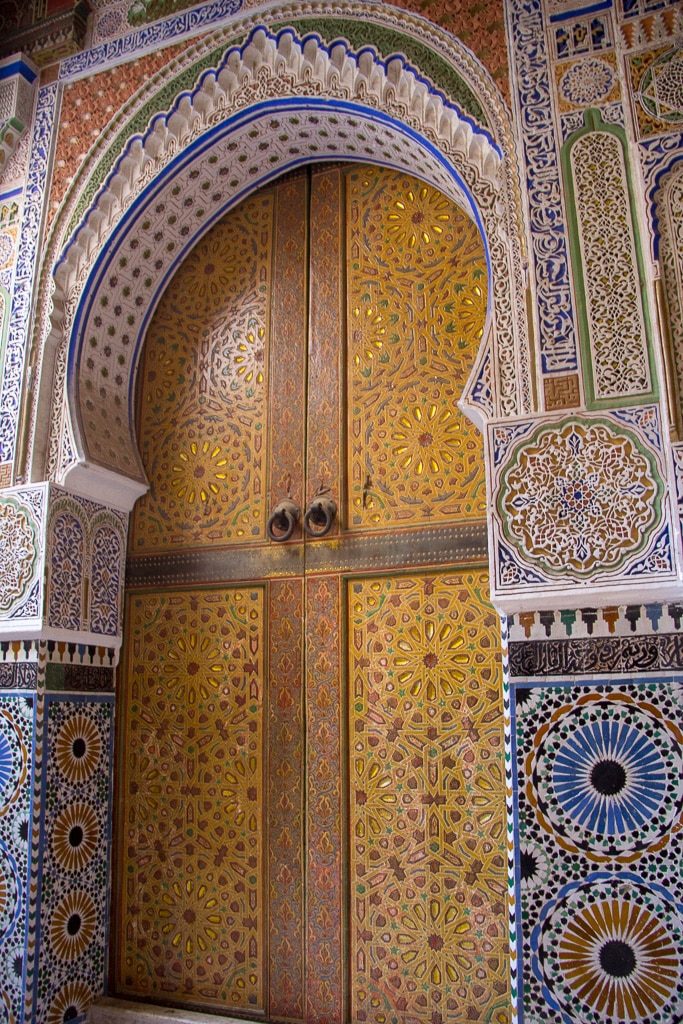
What to Do in Fes (or Fez)
One of Morocco’s Imperial cities, Fes, a UNESCO World Heritage site, remains much as it has for 1200 years. The tourist brochure describes it as a melting pot adding ingredients form the many cultures that have ruled it over the years:
“Arab nobility, Andalusian sophistication, Jewish ingenuity and Berber tenacity”
With such an ancient history there is a lot of things to do in Fes, including many sites of historical and cultural significance to Morocco.
Fes was founded by Idris I in 789 AD. In 817 families started arriving from Cordoba, Spain having been expelled from their homes. Al Quaraouiyine (or Karaouiune), the world’s oldest university opened in 857, you can still see it today. The Quaraouiyine Library dates to the 12th century and houses over 32,000 manuscripts. This is but one of many medersas, (also spelled madrasa) or universities, in the city hundreds of years old. Fez was renowned in ancient times as an intellectual capital. And even today Fez is known as the artistic, religious and intellectual capital of Morocco.
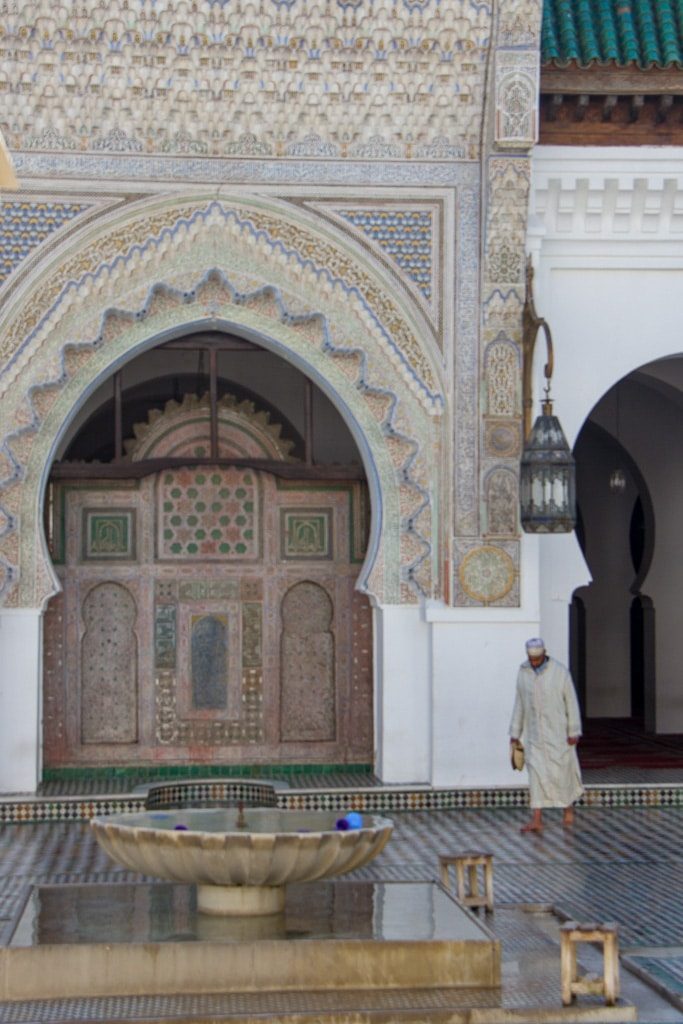
The Nejjarine Museum of Wood Arts and Crafts located within the medina (not far from the Quaraouiyine University) is in a restored foundouk, or traditional guesthouse or caravanserai for traveling merchants. Goods could be stored on the ground level with lodging on the upper levels. The rooftop offers fantastic views of Fez and has a small café.
The Glaoui Palace, the Marrakech home to the Pasha of Marrakech we were first introduced to at Kasbah Telouet on the first day of our desert tour, has fallen into disrepair like many of the magnificent palaces from the wealthy families who once lived in Marrakech.
A walk to the most famous, and newest gate, the Bab Bou Jeloud or Blue Gate at the west entrance to Fes el Bali, the old city of Fez, Morocco, is well worthwhile. The gate, built by the French in 1913, features blue tiles on one side and green on the other. From here, atop a hill, there are lovely views of the city of Fez.
Where to Stay in Fez? Palais Amani Boutique Hotel
Your choice in Fez is to stay within the medina or outside in the more modern, new part of town. There are many large, international hotel chains in the new part of town, most of which, in my opinion, lack traditional, Moroccan character and hospitality.
We like small, boutique hotels reflecting the character of the country in which we are traveling, with a preference for family or locally-owned accommodation. Palais Amani provides a fantastic place to experience Moroccan hospitality and explore the Fes souk or medina.
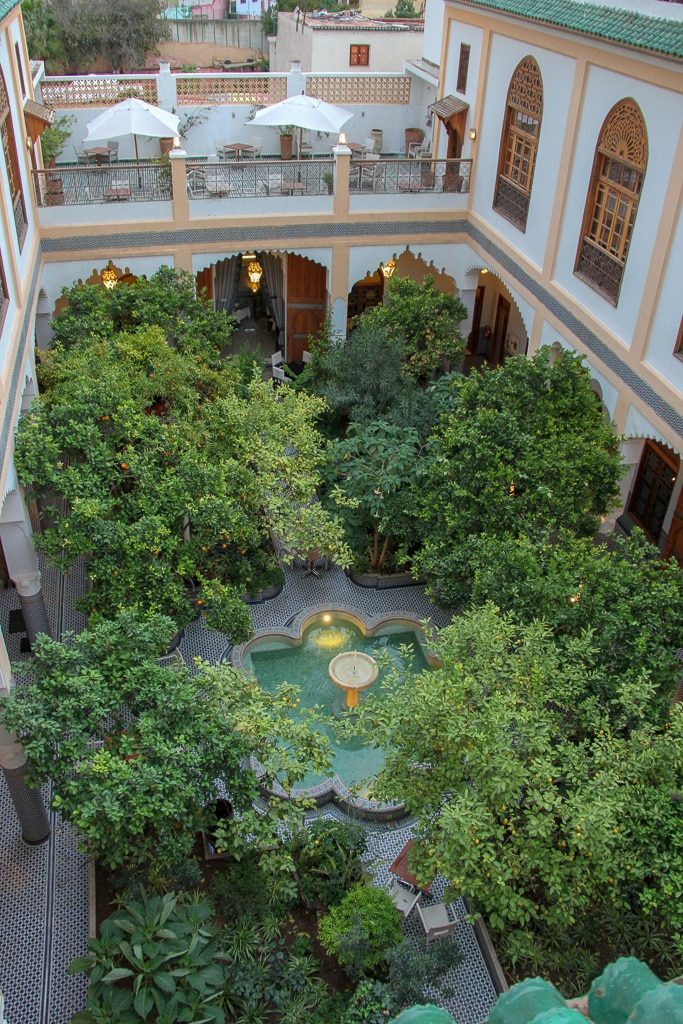
Staying at Palais Amani
All our accommodation in Morocco was nice, but Palais Amani was my favorite. It is simply stunning. After four years of renovation, the hotel opened in 2010. Amani, means “wish” or “desire” in Arabic. The Palais’ original building dates to the 17th century. The more recent owners, the wealthy Lahlou family (bought circa 1920), lived in it until the 1970’s, when many wealthy families moved from the center of Fez.
At one point about 30-40 of the Lahlou’s extended family lived within the walls of the palais and their living quarters have been converted into elegant suites by the current owners, Jemima Mann-Baha and her husband Abdelali Baha.
Over two stories, 15 guest rooms surround a magnificent garden with a large fountain in the center. A large terrace overlooks the garden from one end and a rooftop terrace provides views of the internal courtyard and of Fez.
When you come through the doors from the medina, you enter a quiet, lush garden oasis. Perfect for relaxing after the bustle of the medina.
Visiting the Hammam in Morocco
For Moroccans this is a weekly ritual. In chatting with one of the ladies working at the hotel, she confirmed every week on her day off she visits the hammam. Moroccan women have beautiful hair and skin and one can’t help wondering if this is the reason!
No visit to Morocco would be complete without a visit to the hammam, meaning “hot water” in Arabic, also known as the Moor baths. Steam bathing, an essential part of the hammam experience is also part of the Roman bathing tradition. You see women in the markets crushing the argan nuts to make the soft, oily soap used in the hammam, you can also buy the mineral rich rhassoul clay, another part of the traditional ritual.
There are many options to suit any budget. The public hammam which is very reasonably priced. The “spa” much as though you would visit at home. A private hammam, which you will often find at your accommodation. Our experience was at Palais Amani’s hammam.
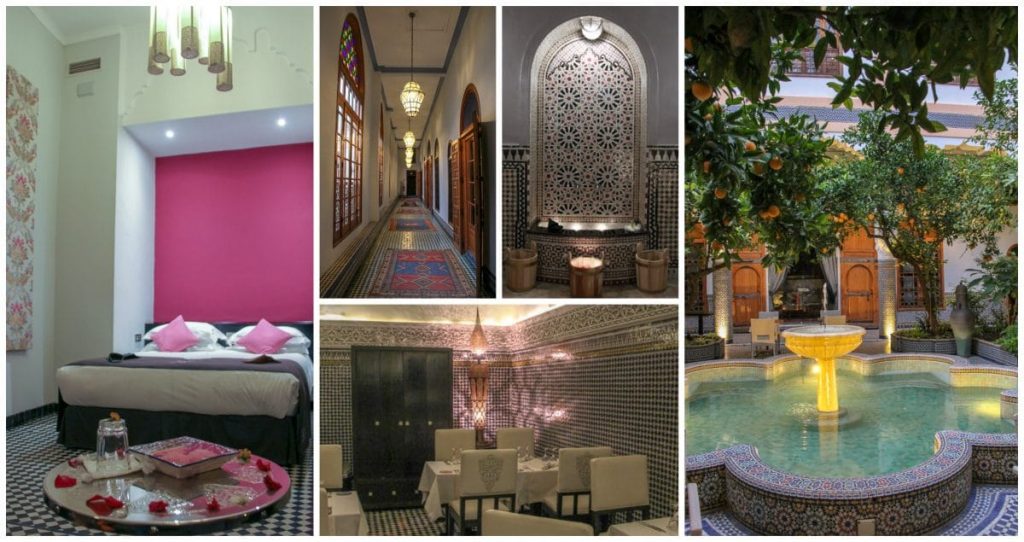
What to Expect When Visiting a Moroccan Hammam?
In a traditional bath house men and women will be separated. The treatment is usually performed naked, but if that makes you uncomfortable you can wear a bathing suit or underwear.
Our treatment was in the hotel and we were the only people in the hammam. Our treatment was together as a couple. (One of the advantages of a private hammam.)
Traditionally a hammam is a warm, steamy environment. In Palais Amani, the hammam is underground to help retain the heat.
The Traditional Hammam Treatment
As we descend the stairs entering the hammam, the room softly glows with candlelight. We sit on benches and the treatment begins with a foot and hand scrub with bath salts. A conditioning clay mask is put on my hair. Mark doesn’t receive the hair treatment. We each have our own attendant who performs the treatment.
From here we move into the large hammam, an open warm and steamy room. Here the washing takes place. The attendant washes and rinses you head to toe with the soft argan and eucalyptus oil hammam soap. A thin layer of mineral rich clay may or may not be applied at this point.
Then you do nothing! Just relax on the bench in the steam for 20 minutes or so which opens your pores for a deep cleanse.
Next a rinse and a vigorous scrubbing follows with a rough mitt which resembles a loofah. This removes dead skin and leaves your skin tingling. Your pores are already open from the steam and this is very stimulating!
A shower follows- in my case to wash the clay from my hair as well. My hair was very soft following this treatment! At this point we are swaddled in our bath robes and led to a lovely relaxation room. After about 20 minutes or so, we head on to a massage. (The massage is not part of a traditional hammam experience, but since you are already relaxed it makes a nice addition.) The hammam experience lasts about 45 minutes.
If you did this in a public hammam it would be a fraction of the cost, but it is also a more public experience and as a couple, an experience you would have separately. While not totally authentic, as most Moroccans visit the public hammam, I am happy with the choice at the hotel. It was most enjoyable and one of those things you must try at least once!
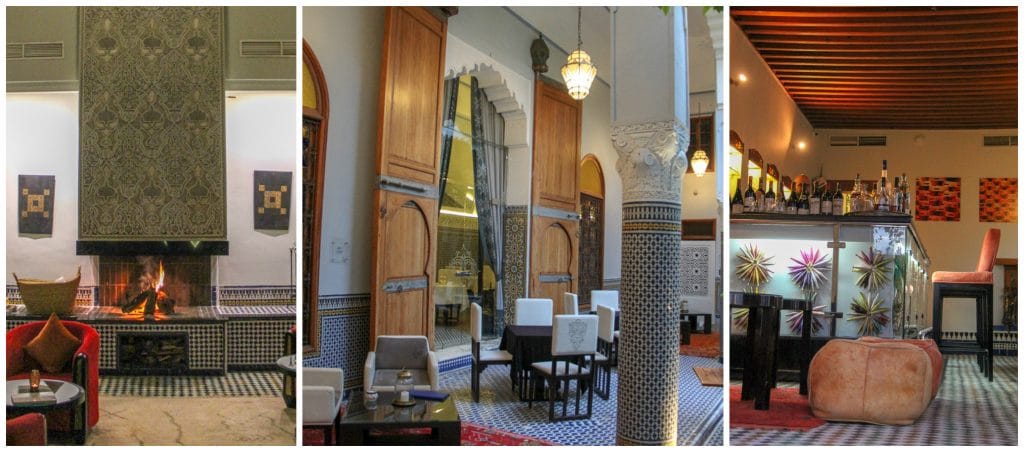
Dining at Palais Amani
Breakfast at Palais Amani is a feast. Each morning breakfast is different, featuring a local item and an array of accompaniments. We had not seen much cheese in Morocco, to the point we asked a couple of people as dairy didn’t seem to be part of their diet. At Palais Amani each morning we had the most divine soft white cheese marinated in olive oil and spices.
Moroccan breakfasts are a feast and a wonderful way to start the day! Many of the items served at Palais Amani for breakfast we had not tried elsewhere in our travels through Morocco. This included wonderful soups and home-made breads.
There is a restaurant which serves lunch and dinner, and two bars. One on the main level which features a fireplace for cooler evenings, and one on the rooftop, for warmer evenings and to enjoy the views of Fez. Both bars serve a menu of local tapas dishes. The restaurant menu changes regularly and features a selection of local cuisine using seasonal produce sourced from the Fez souk.
You can also dine on the terrace overlooking the courtyard or at one of the tables nestled within the gardens.
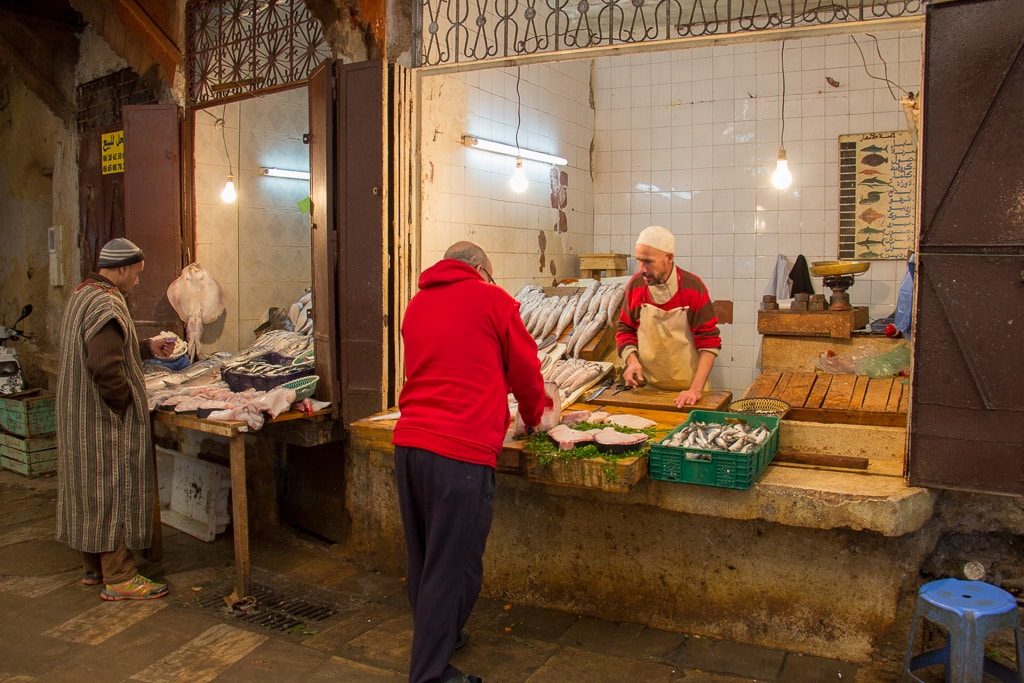
A Moroccan Cookery Workshop at Palais Amani
Shopping in the Fez Medina
If you are at all interested in Moroccan food, (and who isn’t?), Palais Amani also offers cooking classes. The half day course begins with a trip to the souk to shop. I think the most interesting aspect of this was seeing which stalls they shopped in- it was not necessarily the stalls or shops I would have selected.
The meat, in this case fresh chicken, was delivered to the hotel. The fruit, vegetables and spices, we carried with us. A dizzying variety of goods are sold in the market including, fish, beef, chicken, camel meat, fruit and vegetables. Women and children pass, carrying large oven trays of dough. This is bread on its way to the communal oven for baking. They are charged a very small fee per piece for baking. Most households make bread daily.
Cheese, olives, and freshly made pancakes are also sold in the market. Dried meat, an item Fez is known for, is also sold. Many men eat dried meat in a yellow lard mixture for breakfast and lunch. (We tried the dried meat with eggs at Palais Amani one morning for breakfast.)
People shop every day, buying food fresh and there is little refrigeration both in the market and at home.
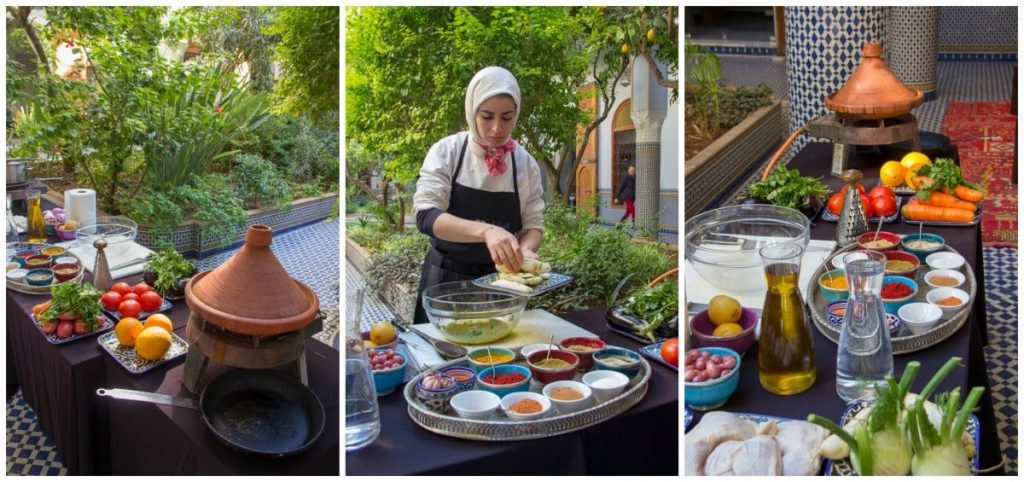
Kitchen Tips from the Pros
Following our shopping excursion, the cooking session begins in the gardens of Palais Amani. The chef and her assistant, demonstrate making an eggplant salad, zaalouk, and a chicken tagine. The garden is a lovely setting for the class, but by the time you visit Palais Amani, your cooking class will most likely take place in their new cooking classroom on the rooftop. The room, which was under construction during our visit, looks fantastic for a cooking class.
There were three in our class and one lady was vegetarian so much to our amazement we learned how to make the chicken separately from the vegetable tagine.
One of the tips we learned in this class was about cooking with olive oil. Because the chef wanted the olive to flavor the chicken (as opposed to using it to brown the chicken), the olive oil was added to the liquid after it boiled and the chicken had begun cooking.
Dessert was a simple recipe of spiced orange slices.
We enjoyed the dishes from the class served with a glass of wine for lunch.
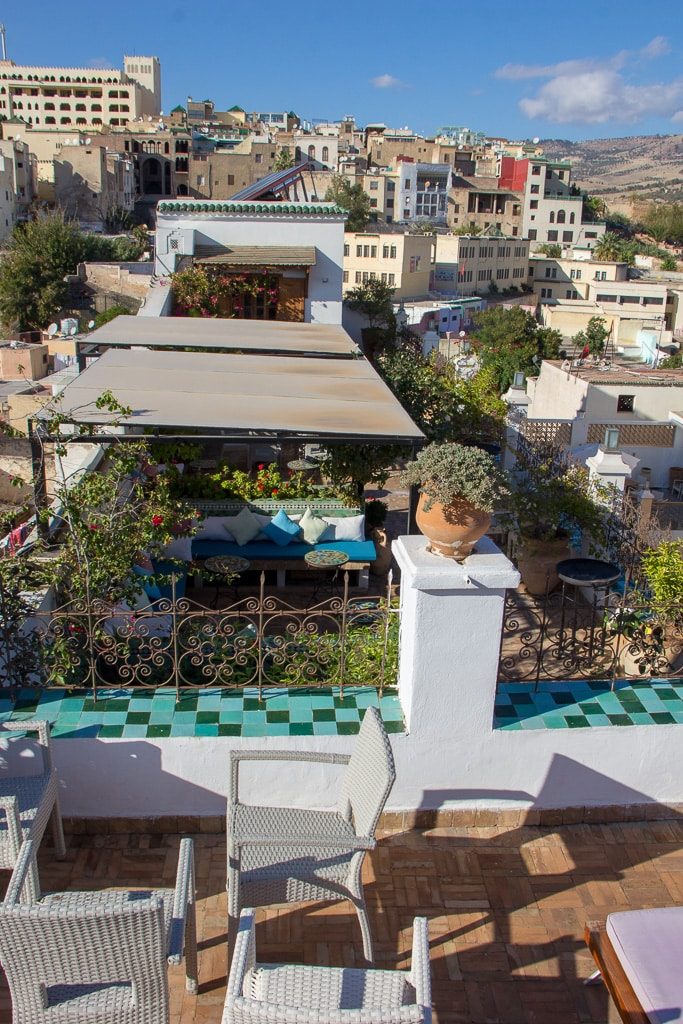
Fez Restaurants and Other Places to Dine
Dining out in Fez is a relatively recent custom, necessitated by growing tourism numbers. When I read articles saying you should be in your accommodation by about 8 pm at night for safety reasons I was intrigued. This is quite different from most places we travel and other places in Morocco including Marrakech.
Having been to Fez, I now understand. There is little to do in the medina in the evening. Most things close around dusk. The narrow, twisting alleyways are largely empty. It is difficult to see around the corners. And while lit, they are not well lit. Basically the place is closed for business so there are few places to go and few people out and about.
Traditionally entertaining for guests was at home so there is not a history or culture of restaurants in Fez. All of which I found fascinating!
So, what do you do for dinner? Well of course there are options. One is to dine at another of Fez riad. Another is to dine at one of the few available restaurants. They have a pick-up service- someone comes to where you are staying and walks you back to the riad or restaurant. This is for both safety and so you can find the restaurant. Keep in mind Fez is hilly so expect a bit of up and down on the walk through the medina. It was fascinating to be “out” in the empty streets in the medina.
Here are a couple of our restaurant recommendations for Fez:
Dar Roumana
A riad in the Fes medina, Dar Roumana offers a pick-up service from your accommodation. Following a twisty, hilly 20-minute walk from Palais Armani (we would have never found it on our own) we arrive at Dar Roumana. It was interesting using the pick-up service and being out “late” in the Fes medina.
A traditional riad, the restaurant is in the internal courtyard. The guest rooms overlook the courtyard. Dinner was 350 dirhams (35 euros) for three courses or 275 dirhams (27 euros) for 2 courses. Alcohol is served.
The interior of the riad is beautiful, the tiles and plaster work intricate. As I sat there eating I decided I could decorate my home in Moroccan style!
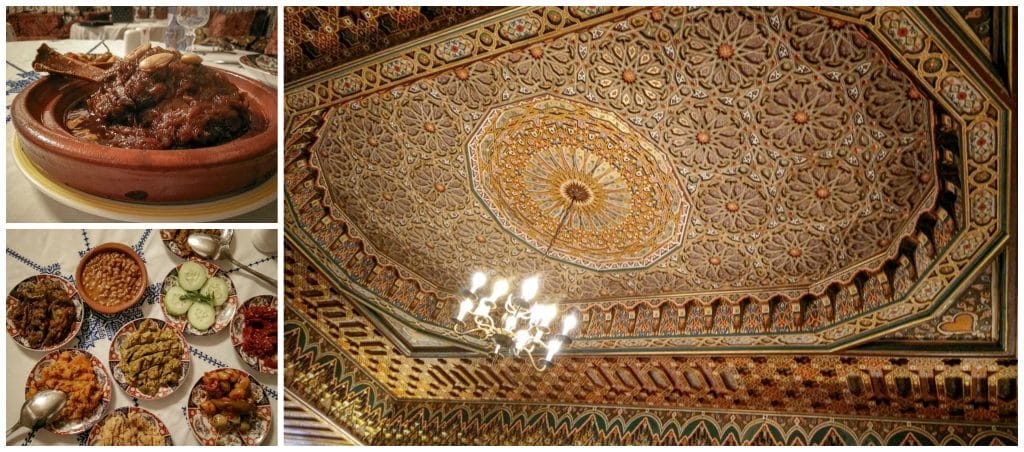
Dar Hatim
This is dinner in a family home within the medina. The Bouaa family have converted part of their home into a beautiful restaurant serving traditional, Moroccan cuisine. The food here was as good as any fine dining experience.
The chicken bastilla (or pastilla), the house specialty, which we highly recommend, was a perfectly spiced combination of sweet and savory! The special of the day was a lamb shank cooked in a tagine, her mother-in-law’s recipe. Melts in your mouth!
Both the tagine and the bastille were the best of the trip and we ate a lot of tagines! A three-course dinner for two (no alcohol) including tax and service was 590 dirhams or 59 euros. Alcohol is not sold, but you can bring your own bottle.
However, I have saved the best for last. You must see the ceiling in this restaurant! On the ground and first floors is the most magnificent carved wooden ceiling, made by her brother-in-law. Stunning! Absolutely stunning. The craftmanship in it is amazing. The details and intricate carvings must be seen to be believed! It took him over a year to make! They are a lovely family and you will enjoy your meal.
Dar Hatim offers a pick-up service. It is very near Palais Armani (about a 5-minute walk).
What to Buy and Where to Shop
Good souvenirs from Fez (and Morocco) include: rugs, slippers (babouche), clothes or scarves (hand-woven), argan oil, pottery, spices, Moroccan lanterns or leather goods.
Wandering through the narrow alley ways of the souks is a highlight of the things to do in Fes and a must when visiting Fez. Still the center of commercial activity in Fez, auctions are held daily in the medina selling wholesale goods to other merchants for resell in shops throughout Morocco.
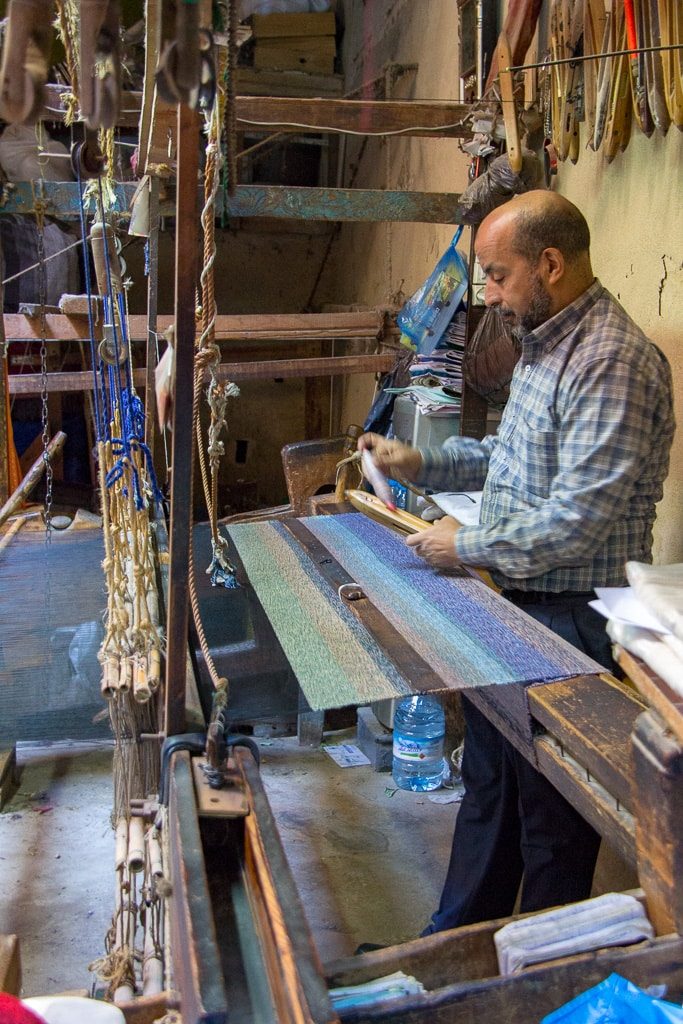
Trades or Souks in the Fez Medina
The medina is organized into souks or trades, here is a list of some of the larger trades:
- Tanners- one of the best-known trades, see below for more details on visiting the tanneries.
- Weavers- making cloth and clothing.
- Pottery- Fez’ blue pottery, since the 11th century, is characterized by intricate floral or geometric motifs and cobalt blue color. The exact formula for the ingredients to achieve the distinctive blue color of tiles and pottery, are a closely guarded secret. (The dark green color you also find in tiles and pottery comes from a mixture of copper, sand and lead oxide.)
- Souk de Henna sells dyes and henna, ingredients for cosmetic products including rhassoul (mineral rich clay used in the hammam) kohl (used in eyeliner and mascara, traditionally lined the eye for its antibacterial properties), and rosewater amongst other things.
- Knife makers and sharpeners
- Embroidery – Fassi (meaning from Fes) embroidery is known for its quality. High quality embroidery is made of very small (2 mm long) stitches on both sides, making the piece reversible.
- Souk Tillis- Carpet or rug makers- see separate article for more information on buying a rug in Morocco
- The Nejjarine district for woodwork including cabinets, tables and chairs. (And the museum dedicated to woodwork.)
- Clothing- traditional Moroccan clothing has intricate embroidery work.
- Metal works- Es-Seffarine Square- you can rent these large pots for a party- trays, teapots- copper, metal, silver and iron works. Wrought iron and metal Moroccan lanterns are found here.
- Souk Attarine- two large doors, one at each end, were the traditional medicine shops
- Babouche or Moroccan slippers. The pointed toes are Arabic, while rounded toes are Berber style slippers.
Take a guided tour of the souks or proceed on your own. A couple of tips if you go independently:
- There is actually an “official” tour route through Fes’ souks. Many of the guides follow this route on the tour.
- There are designated places for each craft. The “official” spot for each craft is marked by a sign. Reading the sign tells you the history and a bit about the guild and their craft.
- The sign is usually outside a shop or vendor the tourism board has “approved”
We went on a guided tour, setting out through the souk with a guide for a couple of hours. He explained the system of signs and designations outlined above.
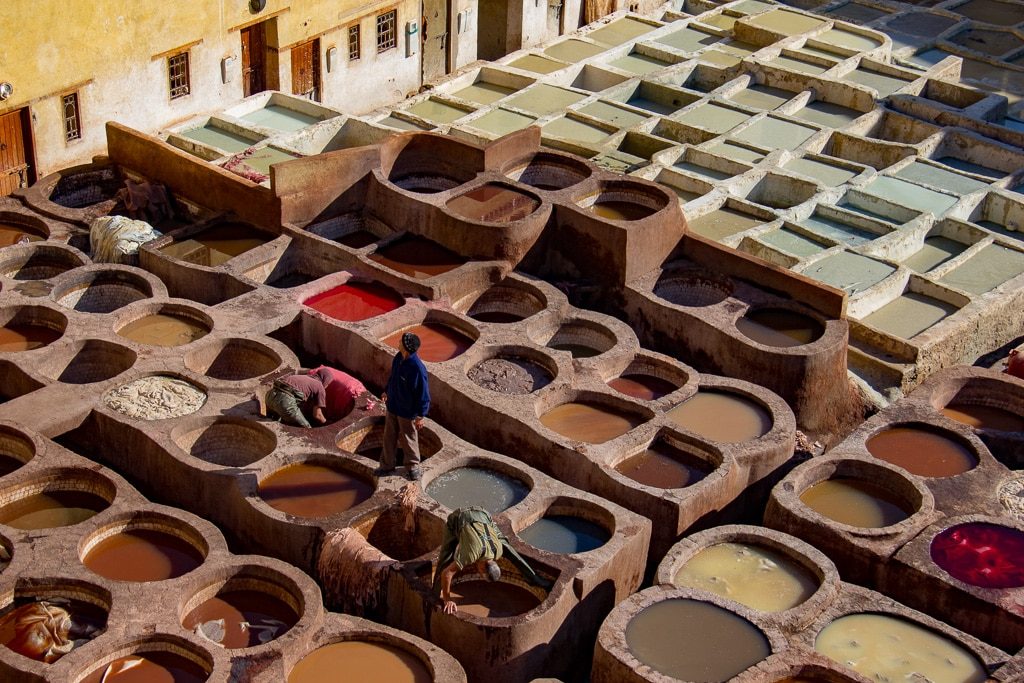
Visiting the Tanneries in Fes
When we were walking through the souk by ourselves, constantly we were offered “assistance” to find the tanneries. When we walk along with a local, no one mentioned the tanneries! Very interesting.
Visiting the tanneries either in Fez or Marrakech is a must. In the Chouwara Tanneries in Fes, work is still undertaken exactly as it has been done for hundreds of years. The smell is awful, but upon entering we were given a “Berber facemask”, a sprig of fresh mint to use to help mask the smell.
Going upstairs to view the vats from one of the many terraces surrounding the tanneries provides a better perspective to understand the process.
How is leather processed in the Fez tannery?
- Softening the skins: The animal skins soak for one week in an open vat which contains lime. You see men in rubber boots stomping on the skins. Cow, goat and sheep skins are used for leather. These are the white vats.
- The skins are then washed and rinsed. This happens in the covered area at the far back right near the open vats.
- Dying the skins- the skins are then placed in open vats once again where dying takes place. Multiple skins are in the same vat. These are the colored vats.
- Red dye is from poppies
- Blue is from indigo
- Yellow is from saffron and due to the expense of saffron these are dyed separately and not in open vats.
There is a vast selection of leather goods on sale. Check if there is a smell to the garment before you buy it- if it smells like the tannery do not buy it- it has not been properly processed and that smell will never go away! The garment should smell like leather (clean leather).
Palais Amani at a Glance
| Name | Palais Amani |
| Where | Fez |
| Style | Moroccan Elegance |
| Atmosphere | Classy, beautiful gardens |
| Type | Small Boutique Hotel inside the Medina |
| # of Rooms | 15 |
| Service | Excellent, friendly and helpful |
| Dining | Breakfast included- served in the restaurant or terrace, 2 bars serving tapas, rooftop terrace and one overlooking the gardens. |
| Additional Services | Hammam and massages. Can arrange tours and transportation. |
| Extras | Cooking School |
| What we Liked | Everything! |
| Recommended For | Perfect for first time Morocco visitors, short breaks, or food lovers. Easy to start or end a longer Morocco trip. |
| Good to Know | 2- night minimum stay. No car required. Exclusive offers available if you book directly on the Palais Amani website. |
Expect to get lost at least once wandering through the medina! It is all part of the fun. Palais Amani offers a wonderful place to stay to see what life was like in the medina for Fez’ wealthy families. The cooking school and hammam are great opportunities to experience Moroccan culture.
We were guests of Palais Amani, all opinions expressed are our own.
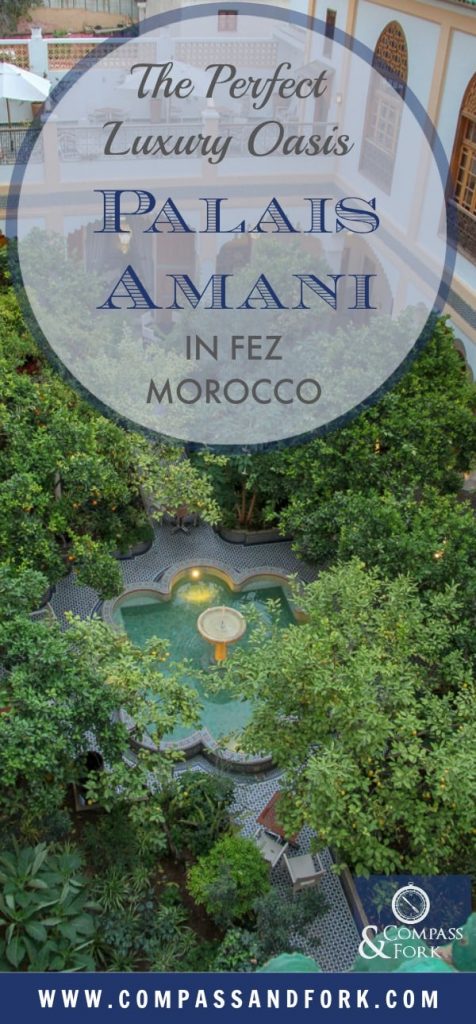 data-pin-description=” “
data-pin-description=” “



Leave a Reply